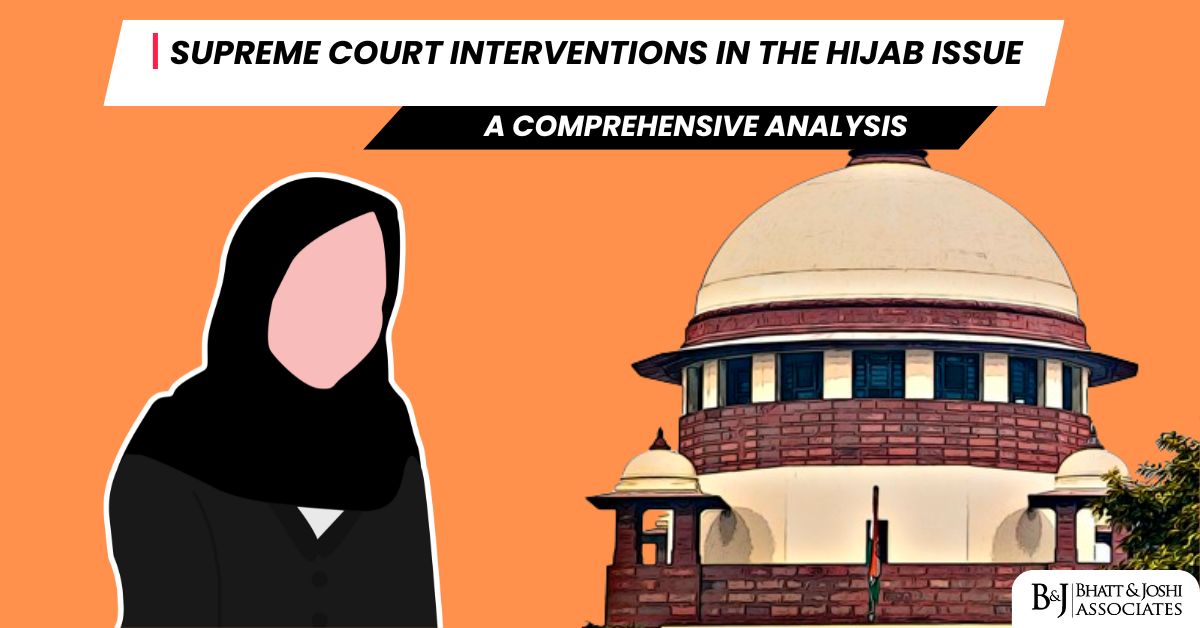Introduction
The hijab controversy in India has seen significant judicial intervention, culminating in landmark Supreme Court proceedings that address the fundamental tension between religious expression and institutional regulations. This report outlines the major Supreme Court interventions in the hijab issue, providing a comprehensive analysis of the legal developments, key arguments, and constitutional questions at stake.
The Karnataka Hijab Ban Case: Split Verdict of October 2022
The most significant Supreme Court intervention came in the form of a split verdict delivered on October 13, 2022, in the case of Aishat Shifa v. State of Karnataka (Civil Appeal No. 7095/2022). This case emerged from a February 2022 controversy when Muslim students at Government Pre-University College in Udupi were prohibited from entering their college while wearing hijabs.
Background of the Case
On February 5, 2022, the Karnataka Government issued an order mandating that students follow the uniform prescribed by College Development Committees. Since hijabs were not included as part of the approved uniform, Muslim students wearing them were denied entry into educational institutions. The Karnataka High Court upheld this ban on March 15, 2022, ruling that wearing hijab was not an Essential Religious Practice (ERP) in Islam.
Multiple petitions challenging this High Court verdict were filed in the Supreme Court, arguing that the ban violated fundamental rights guaranteed by the Constitution of India. After marathon hearings spanning 10 days, the Supreme Court reserved its judgment on September 22, 2022.
The Split Verdict
A two-judge bench comprising Justice Hemant Gupta and Justice Sudhanshu Dhulia delivered a split verdict on October 13, 2022. The diverging opinions highlighted fundamental differences in interpreting religious freedoms and state authority:
Justice Hemant Gupta’s Opinion (Upholding the Ban):
Justice Gupta affirmed the Karnataka High Court judgment, holding that:
- The Government Order was within constitutional bounds and did not contradict any provisions of the Karnataka Education Act of 1983.
- The purpose of the order was to promote uniformity and encourage a secular environment in schools.
- Religious practices cannot be carried into secular schools maintained with state funds.
- The restriction on hijab was a reasonable limitation on fundamental rights under Article 19(2).
- Students have no right to attend schools while violating mandated uniform policies.
Justice Sudhanshu Dhulia’s Opinion (Against the Ban):
Justice Dhulia disagreed fundamentally, concluding that:
- The Essential Religious Practice test was not relevant to resolving the dispute.
- The High Court should have first examined whether the restrictions were valid using the Doctrine of Proportionality.
- Asking schoolgirls to remove hijabs at school gates violated their privacy and dignity.
- The ban infringed upon Articles 19(1)(a) (freedom of expression), 21 (right to life and personal liberty), and 25(1) (freedom of religion) of the Constitution.
- Wearing hijab should be “simply a matter of choice”.
Due to this split verdict, the matter was directed to be placed before the Chief Justice of India for constitution of a larger bench to resolve the dispute.
Mumbai College Hijab Ban Case: August 2024 Intervention
In a more recent development, on August 9, 2024, the Supreme Court stayed a Mumbai college’s circular that banned hijabs, caps, and badges. This case represents the Court’s continued engagement with the hijab issue.
Key Details:
- A bench comprising Justices Sanjiv Khanna and Sanjay Kumar issued notice to the college on a petition filed by three Muslim students challenging the Bombay High Court order that had upheld the college’s circular.
- The Court specifically stayed Clause 2 of the circular prohibiting hijabs, caps, and badges until November 18, 2024.
- However, the Court allowed the college to continue enforcing its ban on burqas, niqabs, or stoles.
During proceedings, Justice Khanna questioned the rationale behind the ban, asking: “What is this? Don’t impose such a rule… what is this? Don’t reveal religion?”. Justice Kumar further probed: “Will their names not reveal religion? Will you ask them to be identified by numbers?”.
Constitutional Questions at Stake
The Supreme Court interventions in the hijab controversy grapple with several fundamental constitutional questions:
- Religious Freedom (Article 25): Whether wearing hijab constitutes an Essential Religious Practice in Islam deserving constitutional protection.
- Freedom of Expression (Article 19): Whether the ban infringes upon students’ right to express themselves through their choice of attire.
- Right to Privacy and Dignity (Article 21): Whether prohibiting hijabs violates students’ personal autonomy and dignity.
- Right to Equality (Article 14): Whether the ban discriminates against Muslim students.
- Educational Rights: The extent to which educational institutions can enforce uniform policies that restrict religious expressions.
Other Relevant Judicial Precedents
The hijab controversy has seen other significant judicial interventions:
- In Amna Bint Basheer v. CBSE (2016), the Kerala High Court held that wearing hijab constitutes an Essential Religious Practice but still allowed for additional security measures during examinations.
- In February 2022, the Supreme Court initially declined to hear urgent appeals against the Karnataka High Court’s interim order banning hijabs, with then-Chief Justice N.V. Ramana noting that the Court would interfere “only at an appropriate time”.
Conclusion
The Supreme Court interventions in the hijab issue reflect the complex interplay between religious freedoms and institutional regulations in India’s constitutional framework. The split verdict of October 2022 underscores the deep divisions on this issue, with Justice Gupta prioritizing institutional discipline and secular spaces, while Justice Dhulia emphasized individual choice and religious expression. As the matter awaits resolution by a larger bench, the Court’s recent stay on the Mumbai college’s hijab ban suggests a continuing judicial willingness to protect religious expression while balancing institutional concerns.
The ultimate resolution of these cases will likely set important precedents for religious freedom and expression in India’s educational institutions and beyond.














